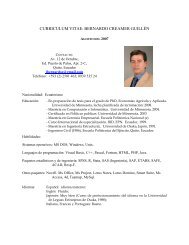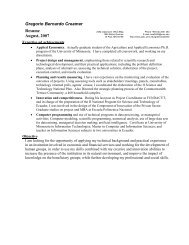Water-Quality Trading: Can We Get the Price of Pollution Right?
Water-Quality Trading: Can We Get the Price of Pollution Right?
Water-Quality Trading: Can We Get the Price of Pollution Right?
You also want an ePaper? Increase the reach of your titles
YUMPU automatically turns print PDFs into web optimized ePapers that Google loves.
1 IntroductionThe idea <strong>of</strong> using water-quality trading (WQT) to aid in protecting water quality is appealing. TheU.S. experience with its SO 2 allowance market proved that markets for pollution can work for air.Should <strong>the</strong>y not work for water pollution too? The U.S. Environmental Protection Agency (EPA)seems to think <strong>the</strong>y can. It actively encourages states to establish rules for water-quality trading(WQT). 2 Currently, <strong>the</strong>re are a total <strong>of</strong> 54 water-quality trading programs in <strong>the</strong> United States,with eleven states having a state-wide trading policy in place or in development and three moreadopting watershed-specific state trading programs (EPA, 2011). The results from <strong>the</strong>se programshave, for <strong>the</strong> most part, been disappointing. Several barriers to trading have emerged (see, forexample, EPA, 2008; King and Kuch, 2003; Morgan and Wolverton, 2005; Woodward and Kaiser,2003).One such barrier is <strong>the</strong> difficulty <strong>of</strong> getting <strong>the</strong> prices <strong>of</strong> pollution right for WQT (Farrow etal., 2005; Hung and Shaw, 2005). By this we mean, following Muller and Mendelsohn (2009) thateach source faces a set <strong>of</strong> permit prices that reflect correctly <strong>the</strong> marginal damages caused over <strong>the</strong>landscape by its own emissions and those <strong>of</strong> its trading partners. The spatial relationship between<strong>the</strong> location <strong>of</strong> air emissions and <strong>the</strong> location <strong>of</strong> resulting damages is well known (Mauzerall et al.,2005). Spatial dependence is likely even more prominent for water pollution, where <strong>the</strong> attenuationand transport characteristics <strong>of</strong> numerous water pollutants are <strong>of</strong>ten critically dependent upon localhydrogeographic conditions at and downstream from each source (Todd and Mays, 2005; Schnoor,1996).Thirty years ago or so a lively literature arose in which various permit-trading schemes wereproposed. Montgomery’s (1972) ground-breaking ambient pollution system (APS) establishes aseparate permit market for every receptor point. This system is impractical, as firms would haveto know <strong>the</strong> impacts <strong>of</strong> <strong>the</strong>ir emissions on all relevant receptors and participate in a number <strong>of</strong>downstream markets. Ano<strong>the</strong>r early contribution is by Atkinson and Tietenberg (1982), who considereda system <strong>of</strong> pollution <strong>of</strong>fsets (POS) in which each new or expanding source is required tobuy <strong>of</strong>fsets from existing sources if <strong>the</strong>ir emissions violate an ambient environmental standard atany receptor point. The emissions must be traded at <strong>the</strong> ratio <strong>of</strong> <strong>the</strong> two sources’ transfer coefficients.A version <strong>of</strong> <strong>the</strong> POS has been used in water-quality trading, but has <strong>of</strong>ten resulted insizable transaction costs, because each bilateral trade must undergo intensive scientific evaluationand ad hoc negotiations with potential trading partners. 3The papers by Montgomery and by Atkingson and Tietenberg belong to a large literature inwhich a host <strong>of</strong> competing arrangements for trading systems were proposed. Most were concerned,ei<strong>the</strong>r explicitly or implicitly, with trading for air quality.A more recent literature, aimed specifically at water trading, focuses on designing tradablepermitsystems that address characteristics specific to water. Our focus is upon two <strong>of</strong> <strong>the</strong> recent2 The Agency’s “<strong>Water</strong>-<strong>Quality</strong> <strong>Trading</strong> Policy” (EPA 2003) and “<strong>Water</strong>-<strong>Quality</strong> <strong>Trading</strong> Assessment Handbook”(EPA 2004) are meant to help guide state and local environmental policy. Improving water quality in a cost-effectivemanner has become a top EPA priority, in part due to a series <strong>of</strong> litigations concerning Section 303(d) <strong>of</strong> <strong>the</strong> Clean<strong>Water</strong> Act (CWA) since <strong>the</strong> 1980’s. The CWA requires all states, territories, and authorized tribes to develop lists<strong>of</strong> “impaired waters” every two years and to develop <strong>the</strong> total maximum daily load (TMDL) for every impairedwaterbody/pollutant. By <strong>the</strong> early 2000’s, EPA was placed under court order, agreeing in a consent decree to enforcea TMDL in 27 litigated cases. A waterbody is designated as “impaired” for a pollutant when it violates ambientwater-quality standards for that pollutant. As <strong>of</strong> September 2010, 39,988 waters were listed as “impaired.” A TMDLis <strong>the</strong> maximum amount <strong>of</strong> a pollutant that a waterbody can receive and still meet water-quality standards. It alsoallocates that load among <strong>the</strong> various sources <strong>of</strong> <strong>the</strong> controlled pollutant.3 In this connection, <strong>the</strong> following comment on Oregon’s <strong>the</strong>rmal-trading initiative makes <strong>the</strong> point: “[T]he tradetook considerable resources on <strong>the</strong> part <strong>of</strong> both CWS and DEQ to develop. The effort would have been nei<strong>the</strong>rpractical nor worthwhile for a source much smaller than CWS to undertake” (Oregon DEQ, 2007).1



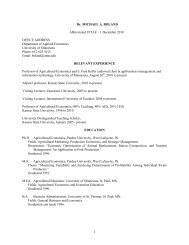
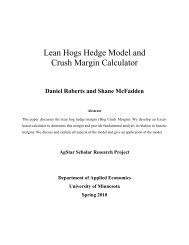
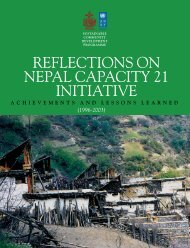
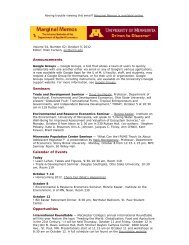

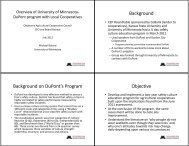
![Publications Since 2000[1].docx](https://img.yumpu.com/30237513/1/190x245/publications-since-20001docx.jpg?quality=85)

